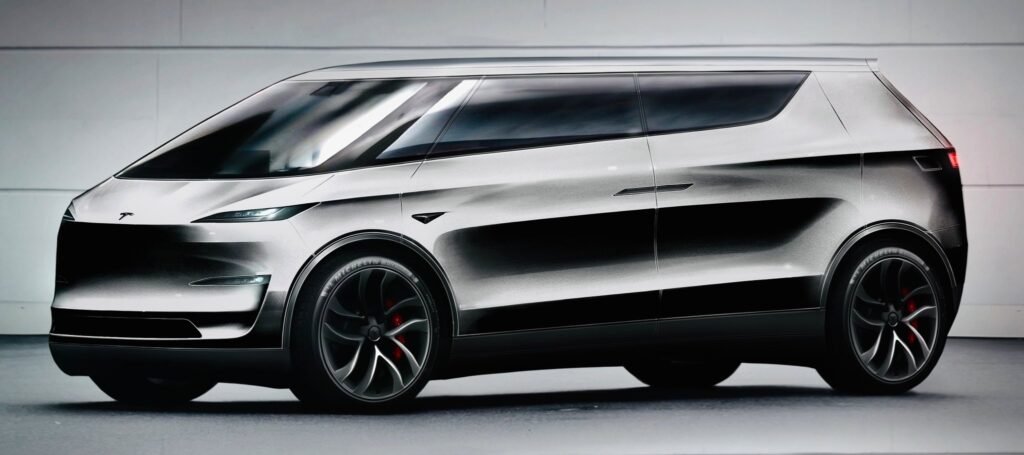We just experienced the unveiling of the Tesla Cybercab, a two-door self-driving taxi. CEO Elon Musk claims will go into production in just three years. Although we have a lot of questions and confusions about the vehicle.
Musk was accompanied to the silver prototype’s butterfly doors by a man dressed like an astronaut, over an hour after Tesla had originally scheduled its launch. Before getting out of the car to join the stage, he made a brief, presumably driverless tour around the eerie, dark streets of Warner Bros. Studios in Southern California.

Subsequently, far from the cluttered, congested streets where a future autonomous vehicle would one day be pushed to operate, Musk referred to the entire arrangement as a “set” in front of an enthusiastic audience of Tesla fans and shareholders.
Tesla also unveiled the “Robovan” that has 20 seats but no steering or pedals. Which means this is another self-driving vehicle.
Musk is infamous for missing deadlines and this time he made some more promises. According to him, fully autonomous driving technology will be available in Texas and California starting the next year. According to him, the Cybercab would eventually cost less than $30,000 and go into production in 2026.
Musk also said that, Tesla owners might be able to send their cars out on their own to offer rides, driving others about to boost the utility of each vehicle by a factor of five to ten. According to Musk, one person may eventually own a fleet of self-driving taxis and “tread them like a shepherd tends to their flock.” Tesla has unveiled prototypes of an app that may resemble Uber and enable a passenger to request a self-driving Tesla taxi. Musk, however, didn’t provide any fresh information regarding the program yet.

Robots were shown in video renderings cleaning the inside of a Cybercab, suggesting a way to maintain cleanliness without the help of a human driver—a concern often associated with autonomous taxis. According to Musk, inductive charging will be used to wirelessly charge the robotaxi. However, no date was given for either of the technological aspects.
Optimus, a humanoid robot that Elon Musk has predicted could ultimately make the company roughly $25 trillion by becoming “the biggest product ever, of any kind,” brought the event to a close. According to Musk, the robot was making progress. Five light-emitting robots danced in a neighboring gazebo to demonstrate this. Following the presentation, other Optimus bots interacted with the audience, taking pictures and dispensing drinks at the bar.

Musk insisted that autonomy and robots will remain at the core of Tesla’s goal in April, seemingly allaying fears that the company was losing its competitive edge in the EV market. This summer, Musk told investors that “autonomy is the value of Tesla overwhelmingly.” In addition, he urged disbelievers to liquidate their Tesla shares.
The event occurs at a crucial moment for Tesla, which is facing more competition in the electric vehicle market from both established automakers and emerging Chinese companies that are exporting low-cost cars to foreign markets for the first time. This year, Tesla has seen a decline in worldwide deliveries, and the carmaker underperformed last quarter in comparison to expert estimates. Earlier this year, the carmaker let go of almost 14,000 workers, many of whom had been involved in the production of batteries and charging infrastructure, which are essential components of electric vehicle production. In the last two weeks alone, the company has lost a number of its key executives.
Tesla’s strategy is very different from what other companies creating self-driving cars are doing. The electric carmaker positions its vehicles in space using only cameras, not a number of sensors. Tesla’s methods enable their cars to make “decisions” while driving by fusing artificial intelligence with this visually-based data. In contrast, rivals “fuse” this data by adding layers of information from lidar, radar, and other sensors. According to Musk, equipping cars with sensors is overly costly and complicates self-driving technology needlessly.
In contrast, Waymo provides paid self-driving taxi services in portions of Los Angeles, Phoenix, Arizona, and the San Francisco Bay Area. According to the corporation, it will make its debut in Atlanta and Austin in 2019. Though they haven’t advanced as far as Tesla, several companies have at least begun the process of getting their autonomous cars approved by authorities and put on the road. The company Zoox, owned by Amazon, is testing driverless cars in San Francisco and Foster City, California, and this year it intends to introduce service in select areas of Las Vegas in specially designed vehicles that resemble toasters. Last year, General Motors’ Cruise service provided paid trips in Austin, Texas, and San Francisco. However, since state and federal regulators said the corporation had deceived them about an October 2023 collision that left a pedestrian gravely injured, the service has had significant setbacks. The company is now resuming testing in a few cities under driver supervision.



